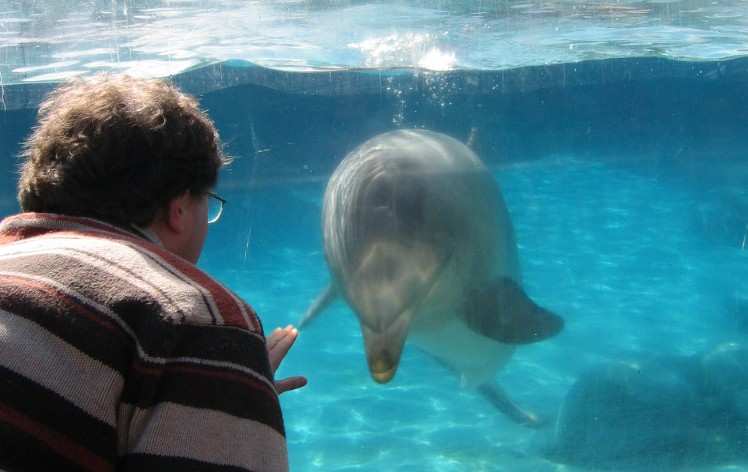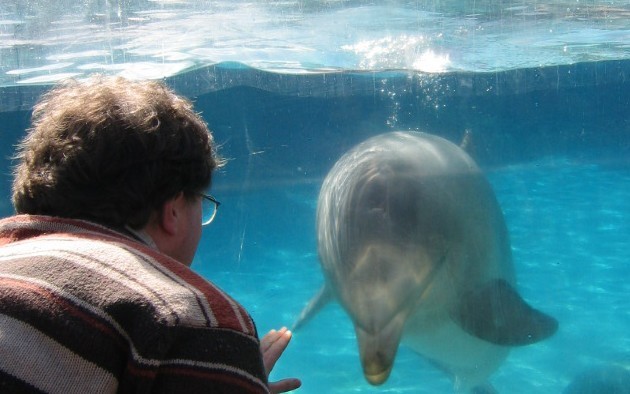|
Let us say the problem is to detect a linearly
scattering target (the 'target') which is difficult to detect because it is
immersed in a cloud of bubbly water. Such a target might be a fish in a dolphin
bubble net - even with a swim bladder, the fish would produce ostensibly
linear scatter from dolphin echolocation because the gas is driven so far from
resonance. Alternatively, it might consist of a military mine which is a
hazard to landing craft because it is hidden from sonar by breaking waves.
Consider if the emitted sonar signal were to consist
of two high
amplitude pulses, one having reverse polarity with respect to the other (Figure
2, top line). Linear reflection from the solid body is shown in Figure 2b(i).
The bubble generates nonlinear radial excursions (Figure 2a(i)) and emits
a corresponding pressure field (Figure 2a(ii)). Whilst the pressure
emitted by the bubble may contain linear and odd-powered nonlinearities, it is
the even powered (e.g. quadratic) nonlinearities which will be insensitive to
the sign or the driving pulse, and hence which can be used to enhance the
scatter from the target over that from the bubbles. It is these quadratic (and
high even-powered components) which will be discussed in Figure 2, and below.
Normal sonar would not be
able to detect the signal from the solid (Figure 2b(i)), as it is swamped
by that from the bubbles (Figure 2a(ii)). If however the returned time
histories are split in the middle and combined to make a time history half as
long, enhancement and suppression occurs. If the two halves of the returned
signals are added, the even-powered nonlinear components of the scattering from the bubble
are enhanced (Figure 2a(iii)), whilst the scatter from linearly
scattering target
is suppressed (Figure 2b(ii)). This can be used to enhance the scatter
from biomedical contrast agents. If however the two halves of each returned
signal are subtracted from one another, the even-powered nonlinear
components of the scattering from the bubbles is
suppressed (Figure 2a(iv)) whilst the reflections from
the solid body are enhanced (with the usual constraints imposed by increased
signal-to-noise ratio) (Figure 2b(iii)).
If echolocation is
the equivalent of vision underwater, then switching from linear to nonlinear
sonar in bubble clouds might find analogy with driving through fog. 'Linear
headlamps' would provide the familiar backscatter from the fog, making detection
of targets difficult (analogous to the intense sonar backscatter from bubbles).
However switching to nonlinear sonar might be equivalent to turning on
'nonlinear headlamps' in a car, which backscatter far less from the fog and so
make driving easier.
The hypothesis is therefore, is
this the way dolphins think?
For associated journal publications, click
on the links below:
Leighton, T.G. From
seas to surgeries, from babbling brooks to baby scans: The acoustics of gas
bubbles in liquids, Invited Review Article for International Journal of
Modern Physics B, 18(25), 2004, 3267-314
Leighton T G,
‘Nonlinear Bubble Dynamics And The Effects On Propagation Through Near-Surface
Bubble Layers,’ High-Frequency Ocean Acoustics, Eds. M.B. Porter, M. Siderius,
and W. Kuperman, 2005, American Institute of Physics, Melville, New York (in
press) (2004)
Leighton T G, Meers S D
and White P R,
Propagation through nonlinear time-dependent bubble clouds, and the estimation
of bubble populations from measured acoustic characteristics.
Proceedings of the Royal Society
A,
460(2049)
2521-2550, 2004
|









